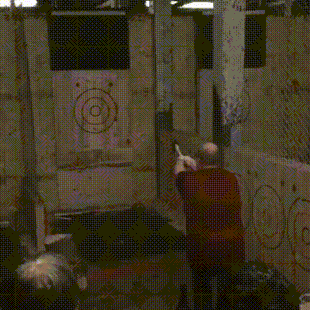Axe throwing
The modern sport of axe throwing involves a competitor throwing an axe at a target, attempting to hit the bullseye as near as possible. Axe throwing has historically been an event in lumberjack competitions.[1] As of the fall of 2020 there are commercial locations in Canada, the United States, Australia, New Zealand, United Kingdom and Poland where participants can compete, similar to dart throwing, as well as opportunities at festivals and some theme parks.[2][3][4][5][6]

Rules
Depending on the type of league, there are different boards and scoring, but the board needs to be made of wood. In 2020 there are 2 very popular leagues: IATF (International Axe Throwing Federation, formerly National Axe Throwing Federation) and WATL (World Axe Throwing League). IATF targets have 4 zones: 3 main and 1 extra – the clutch. WATL targets have 5 main zones and 1 extra. The distance of the throwing line to the target should be around 12 feet to allow the axe to rotate only once, but of course, every league has its own rules for games, distance, board and even axes. For example, when playing IATF classic league matches, the majority of the blade in the board counts but in the WATL it is enough to touch the line to have a point. Matches of both leagues are individual.[7][8]The common rule is that thrower must not step over the throwing line before the axe hits or misses the target; a thrower who steps over the line gets 0 points. Before the competition, a special target for practice throws must be made available. Throwers practicing on the competition target will be disqualified from the competition.[9] There are also championships in other games or trickshots.
There are two main sizes of axes using in the leagues: small (600–800 g) for normal rounds and big (1000–1500 g) for "tiebreakers". Weights previously written apply only to the blade. The rules of IATF allow to play only axes with wooden handles, WATL does not have any restrictions.
History
While axe throwing has been a part of woodsman and timbersports for some time, the resurgent popularity of axe throwing leagues and clubs has been tied to the 2006 formation of the Backyard Axe Throwing League.[10] As of 2020, there are hundreds of axe throwing venues across Canada, USA, Australia, Europe and Thailand. The typical axe throwing venue in North America has at least 5 lanes and a place to sit, watch and write down points. There may also be bars serving beer and other drinks or snacks. The sessions last around 1–2 hours.
Europe
In Europe, the first axe throwing clubs started to open in 2016 in UK (Whistle Punks, London) (Axe Heads, Cornwall) (LumberJaxs, Tamworth/Midlands) and Poland (Axe Nation - axe throwing club, Krakow).[11][12] The one in Poland is the first member of IATF in Europe (joined in 2017) and since that time IATF has become worldwide and changed the name from NATF to IATF.[13]
In 2020 axe throwing is a common sport and entertainment hobby in Europe. It is popular for stag parties, hen parties, team building and many more events. Axe throwing venues are found in UK, Poland, France, Slovenia, Spain, Hungary, Belgium, Netherlands, Czech Republic, etc.
The least expensive axe throwing sessions are in Middle and East Europe (Poland, Slovenia, Hungary) and the prices start from $15 per person. Going west, prices are rising to as high as $100 per person.
Cautions

The sport of axe throwing deals with a potentially dangerous weapon, so the throwing area must be kept safe at all times. If there is an open area behind the target, then spectators and others should be plainly prevented from walking into said area. The target area should be taped off using flags or light fencing materials. A first aid kit and a person trained in first aid and CPR should be at hand in the event of an emergency. For competition in rural and remote areas, the GPS location for the event should be reported in the case of First-Responders being needed.[14]
EuroThrowers
The umbrella association for non-commercial axe throwing sports clubs in Europe is the European Throwing Club 'Flying Blades' (EuroThrowers). With more than 250 direct members from 15 nations, it standardises the competition rules for Europe, which are adhered to by its more than 25 member clubs.[15] The annual World Knife Throwing and Axe Throwing Championship[16] takes place in a different country each year.

See also
References
- "THE HISTORY OF AXE THROWING".
- Heller, Karen (September 30, 2016). "Competitive axe-throwing is an actual thing, and apparently it's best done with beer". The Washington Post. Retrieved December 22, 2016.
- Delean, Paul (November 7, 2016). "Axe-throwing is suddenly all the rage in Montreal". The Gazette. Montreal. Retrieved December 22, 2016.
- Bosker, Bianca (September 2016). "Big in Canada: Throwing Axes for Fun". The Atlantic. Retrieved December 22, 2016.
- Lindner, Matt. "Ax throwing — the 'modern-day bowling' — coming to Chicago". chicagotribune.com. Retrieved 2017-01-03.
- Lindner, Matt. "axe throwing techniques". bestaxeguide.com/. Retrieved 2020-02-03.
- "Home | National Axe Throwing Federation". IATF. Retrieved 2020-02-06.
- "WATL". axethrowing.org. Retrieved 2020-02-06.
- "The rules of Axe Throwing". Archived from the original on 2014-01-31. Retrieved 2014-02-08.
- Knibbs, Kate. "Unbury the Hatchet: How Competitive Ax-Throwing Went From a Canadian Fad to a Global Pastime". The Ringer. Retrieved 2020-10-05.
- Punks, Whistle. "Urban Axe Throwing". Whistle Punks. Retrieved 2020-02-06.
- "Home Page". Axe Nation - najstarszy klub rzucania siekierami w Polsce. Retrieved 2020-02-06.
- "Membership | National Axe Throwing Federation". IATF. Retrieved 2020-02-06.
- http://www.hawkthrowing.com/tomahawk-throwing-competitions.html
- List of EuroThrowers member clubs
- EuroThrowers World Knife and Axe Throwing Championship
